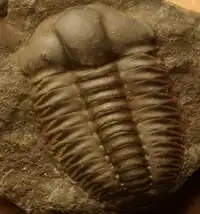Ellipsocephalus
Ellipsocephalus Zenker, 1833,[1] is a genus of blind Cambrian trilobite, comprising benthic species inhabiting deep, poorly lit or aphotic habitats.[2] E. hoffi is a common trilobite mainly from central Europe (Czech Republic).[3]

| Ellipsocephalus Temporal range: Middle Cambrian | |
|---|---|
 | |
| Ellipsocephalus hoffi, Cambrian, Jince Formation, Czech Republic | |
| Scientific classification | |
| Kingdom: | |
| Phylum: | |
| Class: | |
| Order: | |
| Suborder: | |
| Family: | Ellipsocephalidae Matthew, 1887 |
| Genus: | Ellipsocephalus Zenker, 1833 |
| Species | |
| |
Distribution
- E. hoffi (Schlotheim, 1823) [4] occurs in the Middle Cambrian of the Czech Republic, Jince Formation, Ellipsocephalus hoffi–Paradoxides (Rejkocephalus)–Lingulella Biozone of Fatka & Szabad (2014).[5][6]
- E. polytomus Linnarsson, 1877,[7] is widely distributed in the ‘Oelandicus Beds’ (Baltoparadoxides oelandicus Biosuperzone) of Sweden and found near Viken, Näkten lake, Närke and Jämtland. The species is also known from drill cores retrieved from the island of Gotland, Sweden (e.g., Ahlberg 1989).[8][9]
- E. sanctacrucensis (Samsonowicz, 1959) [10][11] is known from the Middle Cambrian of Poland (Słowiec Sandstone Formation, Paradoxides insularis and P. pinus-zones, near Brzechów, Holy Cross Mountains).[12]
Description
Ellipsocephalus is approximately oval in shape and markedly convex. It has opistoparian facial sutures that are directed slightly outward from both front and back of the eyes. The glabella has approximately parallel, slightly concave sides and is rounded frontally. Lateral furrows are indiscernible, as is the occipital ring. The palpebral lobes are not distinctly separated from the narrow occular ridges. The preglabellar field is somewhat inflated and librigenae are half as wide as the fixigenae. Some species have genal spines (as in E. sanctacrucensis), whereas in the most common species (E. hoffi) the genae lack spines and are only slightly angular posterolaterally. Ellipsocephalus has 12 thoracic segments and the pygidium is 4× wider than long.[13]
Behaviour
Ellipsocephalus and some other primitive micropygous Cambrian genera, such as Bailiella, enroll differently from other trilobites so that the posterior thorax segments and pygidium bend under the thorax. This is called "double enrollment".[13]
References
- ZENKER, J. C., 1833. Beiträge zur Naturgesichte der Urwelt. Organische Reste (Petrefacten) aus der Altenbruger BraunkohlenFormation, dem Blankenburger Quadersandstein, Jenaischen bunten Sandstein und Böhmischen Uebergangsgebirge. Friedrich Mauke, Jena, 67
- "Trends in benthic trilobites".
- "Jince formation".
- SCHLOTHEIM, E.F., 1823. Nachträge zur Petrefactenkunde. Zw. Abteilung, Becker, Gotha, 114 pp.
- FATKA, O. & SZABAD, M., 2014. Biostratigraphy of Cambrian in the Příbram-Jince Basin (Barrandian area, Czech Republic). Bulletin of Geosciences, 88, 413–429.
- S.M. GON III. "Trilobites of the Jince Formation, Czech Republic". Retrieved 19 October 2012.
- LINNARSSON, G., 1877. Om faunan i lagren med Paradoxides ölandicus. Geologiska Föreningens i Stockholm Förhandlingar, 3, pp. 352 – 375
- AHLBERG, P., 1989. Cambrian stratigraphy of the När 1 deep well, Gotland. Geologiska Föreningens i Stockholm Förhandlingar, 111, 137–148.
- RUSHTON, A. W. A.; WEIDNER, T. (2007). "The Middle Cambrian paradoxidid trilobite Hydrocephalus from Jämtland, central Sweden" (PDF). Acta Geologica Polonica. 57 (4): 391–401. Retrieved 30 March 2013.
- SAMSONOWICZ, J. 1959a. On Strenuaeva from Lower Cambrian in Klimontów Anticlinorium. ´ Bulletin de l’Académie Polonaise des Sciences, Série des sciences chimiques, géologiques et géographiques. 7, pp. 521 – 4.
- SAMSONOWICZ, J. 1959b. On Strenuella and Germaropyge from the Lower Cambrian in the Klimontów Anticlinorium. Bulletin de l’Academie Polonaise des Sciences, Série des sciences chimiques, géologiques et géographiques, 7, 525 – 9.
- MASSIAK, M.; ŽYLIŃSKA, A. (1994). "Burgess shale-type fossils in Cambrian sandstones of the Holy Cross Mountains" (PDF). Acta Palaeontologica Polonica. 39 (4): 329–340.
- MOORE, R. C. (1959). Arthropoda I - Arthropoda General Features, Proarthropoda, Euarthropoda General Features, Trilobitomorpha. Treatise on Invertebrate Paleontology. Vol. Part O. Boulder, Colorado/Lawrence, Kansas: Geological Society of America/University of Kansas Press. pp. 1–560. ISBN 0-8137-3015-5.